
Illustration 9 - The Delusional Solution by Splitting
CHAPTER 7
|
TABLE
OF CONTENTS FOUNDATIONS OF PSYCHOHISTORY by LLOYD DEMAUSE |
308

Illustration 9 - The Delusional Solution by Splitting
placental American flag and drawn in white, is shown at the left. The bad leader, the Poisonous Placenta, old, foreign-looking and drawn in black, is shown at the right. The price of the split, squeezed in birth agony by the um-bilical rope the two leaders pull between them, is the sacrificial hostages. These hostages were vitally necessary to the delusional solution. As William F. Buckley said, the real danger was that they might be freed without violence:
But what if the Ayatollah merely frees the prisoners... The public will be left with the sense of an unconsummated transaction. We will be looking to Carter to see what form he elects for punishing the enduring government of Iran, and here is the rub. It is unlikely, the hostages having been returned, that the U.S. will want direct military action of the kind that results in death for men, women and children.(254)
During the early months of 1980, the unconscious aim of American policy was to keep the hostages in captivity, even to provoke their death, as a cleansing sacrifice and as a punishment for our rage. The Shah was officially escorted around to various military hospitals by Air Force planes, infuriating the Iranians, and the press constantly played up Carter's speeches of his "readiness to use military force" regardless of the consequences. After the Shah finally left the U.S., Carter even wrote what the New York Times called an "inexplicable" letter to the Shah's sister, asking him back, saying "Our preference now is that he receive treatment under
309
Dr. DeBakey's care either at Gorgas, the U.S. hospital in Panama, or in Houston, Texas -a move which was tantamount to a death sentence for the hostages. "We were certain," Hamilton Jordan recalled later, "that if the Shah exercised his right to come back to the United States, some of the hostages would be killed. We had real warnings to that effect."(256)
Yet some direct action still had to be taken to produce the sacrificial violence that would end the upheaval stage of the group-fantasy of rebirth. In fantasy, it was not just a diplomatic matter: in fantasy, a horrible Poisonous Placenta was still strangling the nation and cutting off its oxygen supply. Time magazine dramatically portrayed how we felt just before the military action against Iran (Illustration 10), showing placental flags plastered over our faces and umbilical ropes tied around our chests, as direct a reliving of our own birth as can be portrayed. American reporters tried to explain to puzzled Europeans who were not part of the birth group-fantasy why "Seldom has there been more talk of war, its certainty, its necessity, its desirability. "(257) Amidst demands that he "stiffen the national spine" and "take charge" to allow America to reach the "light at the end of the tunnel.. about to be born,"(258) after a major "economic" speech which saw a "NEED FOR PAIN AND DISCIPLINE,"(259) and backed by polls now showing a majority of Americans favoring invasion even if hostages were killed, Carter gave the go-ahead to a "rescue raid."
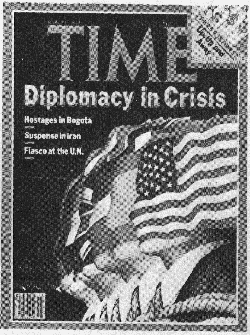
Illustration 10 - Suffocation By Poisonous Placenta During Birth
310
That the military raid was bound to result in the death of many if not most of the hostages was considered certain, by Carter, by Vance, by his advisors, and by the Pentagon.(260) Yet a "sacrifice for national honor" was finally deemed necessary: the poisonous bestial enemy must be defeated and the birth upheaval terminated. As Brzezinski put it during the April 11th meeting of the National Security Council at which the decision to invade was made, America had to "lance the boil,"(261) thus ending the infection, the pollution of the national body.
But the "rebirth of American will" was not to be accomplished that day in April - the military action had to be "aborted." No Iranians and no hostages were sacrificed, and no defeat of the monstrous enemy was accomplished. Instead, only humiliation and defeat, and eight dead Americans left on the sands of Iran. Carter took full responsibility for pulling back the task force and for not using the alternative plan to continue the assault with the hundreds of planes and ships in the area. Again, this strength of character on Carter's part in deciding not to risk full-scale war was considered "weakness" by his critics. As Richard Nixon, who often blurts out the unsayable feelings of the nation, later put it, "one of the major errors that President Carter made [was] that his primary, and in fact it seemed to me his only concern.. was the lives and safety of the hostages."(262) Carter would not be forgiven this "weakness." It now felt like America was choking" on a "bone in the throat" from its own "powerlessness."(263) The national rebirth would have to be accomplished another way: through the cleansing sacrificial death of the leader himself.
Like the ritual sacrifice of the divine king of archaic societies, it is always possible to clear up the group pollution by stoning the old, impotent leader to death. America conducted the defeat of Jimmy Carter in the election of 1980 in an atmosphere filled with overt death wishes. Cartoons constantly showed him falling to his death and otherwise being killed. In August - exactly 17 years after the assassination of President Kennedy - 70 million Americans were glued to their TV sets to find out "Who Shot J.R.?" Carter's final "landslide defeat" was pictured as a painful "stoning" to death of Carter by Reagan (Illustration 11). The portrait of Carter in defeat
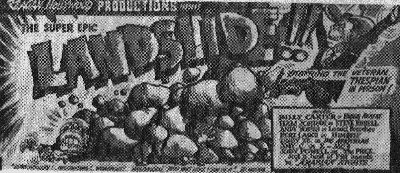
Illustration 11 - Sacrificial Stoning of Divine King
311
printed near the cartoon appeared to confirm the actuality of his death. (Illustration 12.)
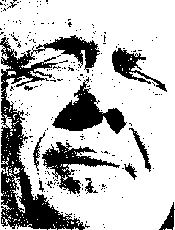
Illustration 12 - Proof of Carter's Death
America was quite clear about the reason for the ritual sacrifice of Carter. In the "struggle between anger (at Carter) and fear (of Reagan).. anger would win by a landslide," said one reporter. "That was no election. That was Mount St. Helens, pouring hot ash over the whole political landscape."(264) A Fantasy Analysis of Time's post-election article on Carter's defeat sounded like the report of a Spanish priest watching a bloody Aztec sacrifice in horror: "savage.. angry.. buried.. ..... triumph.. dismembered.. killed.. happier.. flesh.. ...... tears.. ......... hurt.. hell."(265) Jimmy Carter had refused to clear out our pollution by sacrificing Americans; he himself then had to be sacrificed. His mistake was in not recognizing the ultimate source of the pollution: in ourselves. As Tom Wolfe put it:
People were just waiting for Carter to say, "You know what you've been doing, I know what you've been doing, we're not kidding each other. You're all out there cheating on your wives and your husbands.. You're letting your communities sink in a sump of decadence and corruption, and you're encouraging lust and pornography. It's no secret and it's time that we did something about this cesspool of immorality."(266)
Wolfe entitled his article "Let's Have a Call To Arms." The person who responded to this call to arms to stem the disintegration and pollution of an
312
immoral America was Ronald Reagan, who had been preaching just these themes for decades. His nomination acceptance speech left little doubt as to his recognition of his fantasy role in the fetal drama of national disintegration and rebirth through violent sacrifice:
Destroy.. disintegrating.. weakened.. calamity.. sacrifice... destroy.. rebirth.. eaten away.. wasted away.. renew.. ......... sacrifice.. flows like a mighty river.. ....... .injure.. turned the na-tional stomach.. destroy.. freeze.. exhaustion.. destruction... weakness.. .disasters.. weakness.. ...... war.. war.. blaze.. (267)
After Reagan's election, a two-month timeless "intercalary period" intervened, when, as in archaic times, the old leader is mourned, the new leader takes on the placental attributes and time is again renewed.(268) Finally in January 1981, Reagan took over his office in a burst of rebirth imagery. His inauguration, which coincided with the return of the hostages, was celebrated by a nation awash with millions of placental flags and yellow umbilical ribbons - symbols both of the reestablishment of the tie to the new leader and to the hostages who had returned to life after they had been wished dead. Normally unemotional TV announcers vied with each other to sing their praises of the national rebirth: "After 20 years of pessimism, after assassinations, Vietnam and Watergate, at last the burden was off our backs. It was America Reborn, America All the Way!"(269) "It was like a wedding where the birth of a bridesmaid's baby upstaged the groom."(270) "It's like carrying a baby . . . like a rebirth."(271) The ticker-tape procession for the hostages produced "crowds sometimes ten deep (which] lined the 17-mile route, cheering, laughing, weeping and waving flags, and, of course, yellow ribbons."(272) The yellow ribbons proved so potent a symbolic umbilicus that tens of millions of them were hung on trees and poles all around America, just as the aborigines hung the umbilicus itself on trees. And, just as other primitives ritually burned the umbilicuses of newborn babies, American radio stations broadcast appeals to send the yellow ribbons to a special Post Office Box in Florida so they, too, could be burned all together in a special ritual in honor of the reborn hostages.
Ronald Reagan was shown in cartoons as a proud father handing out cigars for the birth of his new babies, as a placental balloon with a yellow umbilical ribbon shining over the White House, and as feeding everyone. The New York Times anointed him as "the first President in years who.. is radiating charm, decency-and competence," and the Washington Post confirmed that "all of Washington and most of America seems to be wrapped in a bubble of euphoria inflated by Ronald Reagan...'"(273)
313
Yet to a psychohistorian, all this euphoria seemed more manic than joyful. Carter had not in fact died, the hostages had not died, no one - except for the quickly forgotten eight soldiers - had died a sacrificial death, so the poisonous Placenta was still raging nearby, panting for the blood of its sacrificial victim. The cartoon in Illustration 13 dramatically portrays American group-fantasy on the day of Reagan's inauguration-with the Poisonous Placenta barely kept in control by the slashing sword of a worried Reagan.
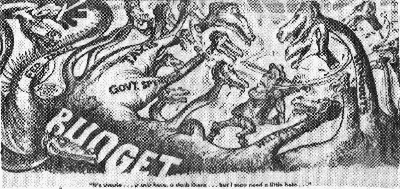
Illustration 13-Poisonous Placenta as Reagan Becomes President
Although most "honeymoon periods" of other presidents are low in angry fantasy language, it soon became apparent to perceptive observers that "despite the relaxed banter of the President in news conferences and despite the approving polls, there is a low, mean hiss to be heard in the land [as shown by] the snarling, deliberately nasty way people are coming to treat each other."(274) Reagan asked his staff to be "meaner than junkyard dogs" in slashing the budget, headlines of "CUT, SLASH, CHOP" were repeated everywhere in the media, and cartoons laughingly depicted everyone from government employees to babies and the elderly being chopped in half by axes and swords.(275) Despite the fact that federal government employees were actually 100,000 fewer than a decade earlier, Washington itself was identified as a bloated Poisonous Placenta with tentacles choking the people. The government itself therefore had to be chopped into pieces-no matter that the results were "cruel, inhumane and unfair,"(276) or that Congressmen could say of the slashing "it's heartbreaking. We spent years putting these programs together and they work. Now they are being destroyed."(276) American pollution had remained uncleansed by sacrificial death. Therefore, the government itself had to perform an act of self-castration as a magical gesture to restore the fertility of the polluted land-exactly as priests of Cyble used to castrate themself to satisfy the fury of their goddess. Sadistic horror movies were now considered as "the new
314
wave," featuring bloody "cut, slash, chop" scenes that paralleled Reagan's budget cartoons.(277) The Anti-Defamation League reported a threefold increase in anti-Semitic incidents from the previous year; the C.I.A. was "unleashed"; and Reagan's five-year budget plan provided for over a trillion dollars more of horrible new weapons and for a quarter million additional military personnel-representing a military buildup that was "three times as large as the one that took place during the Vietnam War."(278) The placental beast remained so near that when he spoke to the country Reagan told Americans his main job was going to be "holding back an evil force that would extinguish the light we've been tending for 6,000 years.' '(279)
National magazines reported the steady rise in undischarged American rage quite openly. Harper's reported that "the fevers of war are once again upon us.. beneath the surface of recent American events can be felt the gathering strength of attitudes and emotions that permit us to think about war in ways that were impossible even a year ago."(280) The New Republic told the same story from inside the administration:
For the first time since the 1950s, the possibility of nuclear war with the Soviet Union appears to be seriously accepted by key figures inside and outside the U.S. government. What long have been unthinkable thoughts now are entertained by influential men and women in Washington.. .A senior White House foreign policy specialist says: "In 30 years, I never thought war was really possible: now I think it is possible.. "(281)
The cleansing sacrificial climax to the fetal drama seemed to be unreachable. During the month of March, 1980 a new group-fantasy developed in America: since Reagan was unable to provide the necessary cleansing violence, he would have to be scarified too! Perhaps a martyr's blood could fertilize and cleanse the polluted nation. As can be seen in Illustration 14, in the final weeks of March, the media broke out in an orgy of front-page suggestions that Reagan should be shot, from the threatening revolvers on the covers of both Time and Newsweek to the graves in front of the U.S. Capitol Building on the cover of The New Republic. The cover of U.S. News the same week featured a picture of what it called "angry, frustrated" Americans under a headline that said '$60 BILLION OF FEDERAL WASTE-REAGAN'S NEXT TARGET," thus artfully com-bining the message "WASTE [shoot] REAGAN" with the equally explicit delegation that "REAGAN'S [is the] NEXT TARGET."(282) There was such an outpouring of media imagery suggesting that Reagan be shot during this week that, at a meeting of our Institute for Psychohistory's on-going Reagan Fantasy Committee, we discussed our concern that the media
315

Illustration 14 - Delegating the Shooting of Reagan
All cartoons and covers appeared prior to the shooting of Reagan.
316
covers and all the stories with "shoot... kill ...die" in them might soon lead to an assassination attempt.
These assassination commands were the images on the news stands when the psychotic gunman pulled the trigger and shot the President. Since Hinckley had been in possession of weapons when he was in the same city as President Carter several months earlier without shooting, it is quite possible that now he pulled the trigger as a delegate of the national group-fantasy. Less stable personalities often act as history's sensitive receptors of hidden messages. Alexander Haig, for instance, the most unstable personality within the Reagan group, must have picked up the shooting messages too, since he began to argue the question of proper lines of succession to the President several days before the shooting, as though he felt it coming. The reactions of the rest of the country also seemed to reflect people's unconscious complicity in the shooting. Several newspapers reported local classes of children breaking into cheers on hearing of the assassination attempt. After the shooting, Hinckley's name disappeared from the press. One newspaper editor asked after the shooting, "Why Isn't Reagan Angry? Why Aren't We All Angry?"(283) No one was really angry at the shooting, no one - including Reagan and his wife - pushed for gun control, because everyone knew the shooting was necessary. Hadn't many Americans been predicting with a laugh for months that Reagan would die in office (supposedly because all American presidents elected in a year ending in zero did so)? Hadn't "Re-elect Bush in 1984" been on many car bumpers since Reagan's election? Just as Kennedy had to be shot a year after the Cuban Missile "Crisis" failed to really cleanse the national pollution and rage, so, too, Reagan had to be shot a year after the Iranian "Crisis" failed to cleanse the nation. The difference, of course, was that Kennedy died, and Reagan didn't. The long - desired rebirth had been aborted again - and one week after the shooting Time'ss front cover displayed our feeling with the one-word headline: "ABORTION."
Before long, therefore, national group-fantasy would call for another sacrificial victim to play out the final cleansing act of the fetal drama. Just as Christians for centuries had been transfixed in adoration before a placental Sacred Heart of Jesus, complete with a vaginal wound and glowing with life, so too Americans now found on their newsstands after the shooting a picture (Illustration 15) of the placental Sacred Heart of Reagan, the Crucified One who had risen again-complete with a vaginal door and glowing with new life-symbol both of the placental source of life in the womb and of the sacrificial violence yet to come.
317
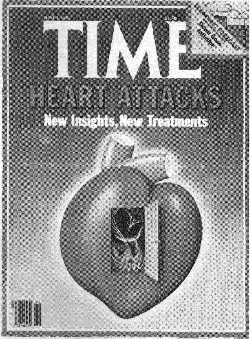
Illustration 15 - Placental Sacred Heart of Reagan
| FOUNDATIONS OF PSYCHOHISTORY TABLE OF CONTENTS |
on to page
|
by: Lloyd deMause
The Institute for Psychohistory
140 Riverside Drive, NY NY 10024
To report errors in this electronic
transcription please contact:
[email protected]